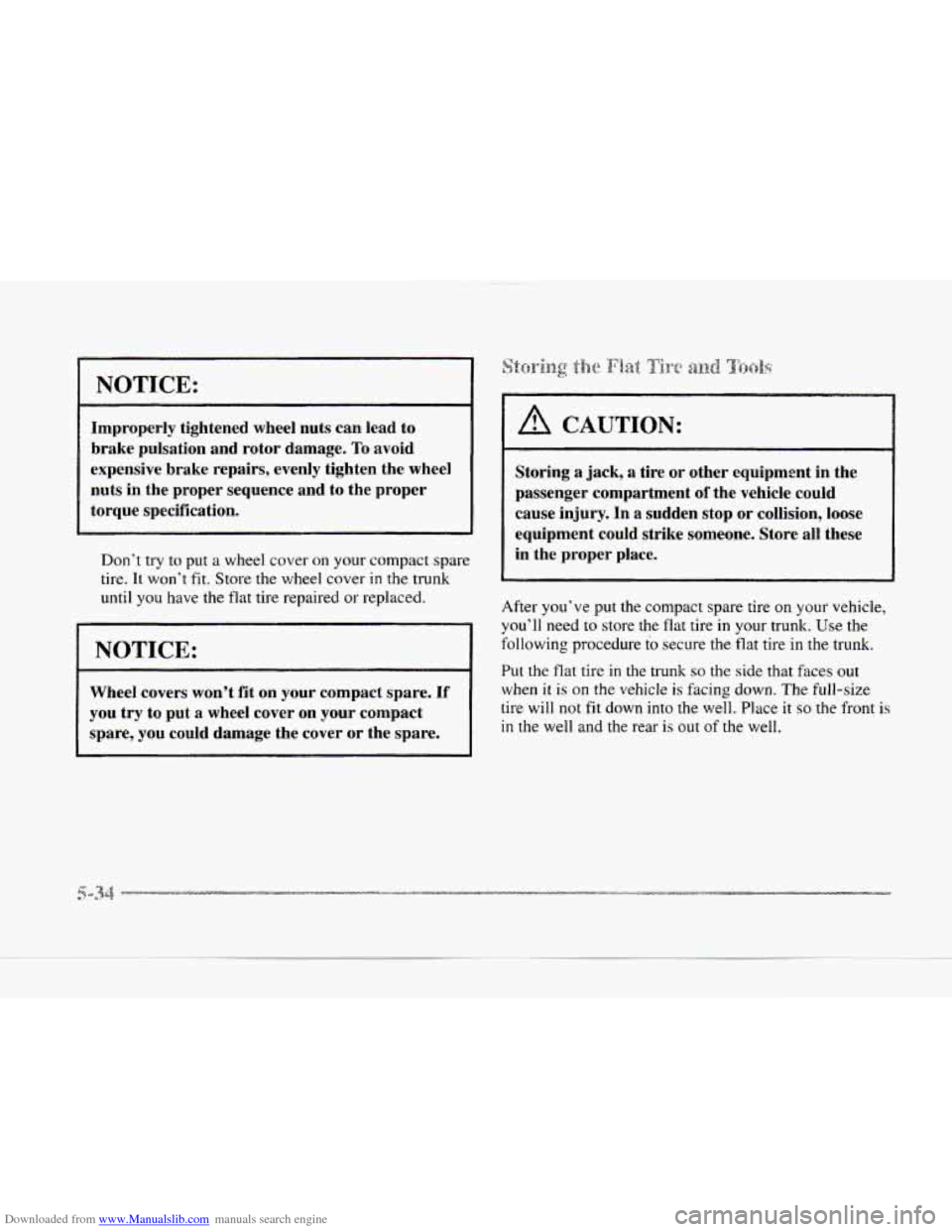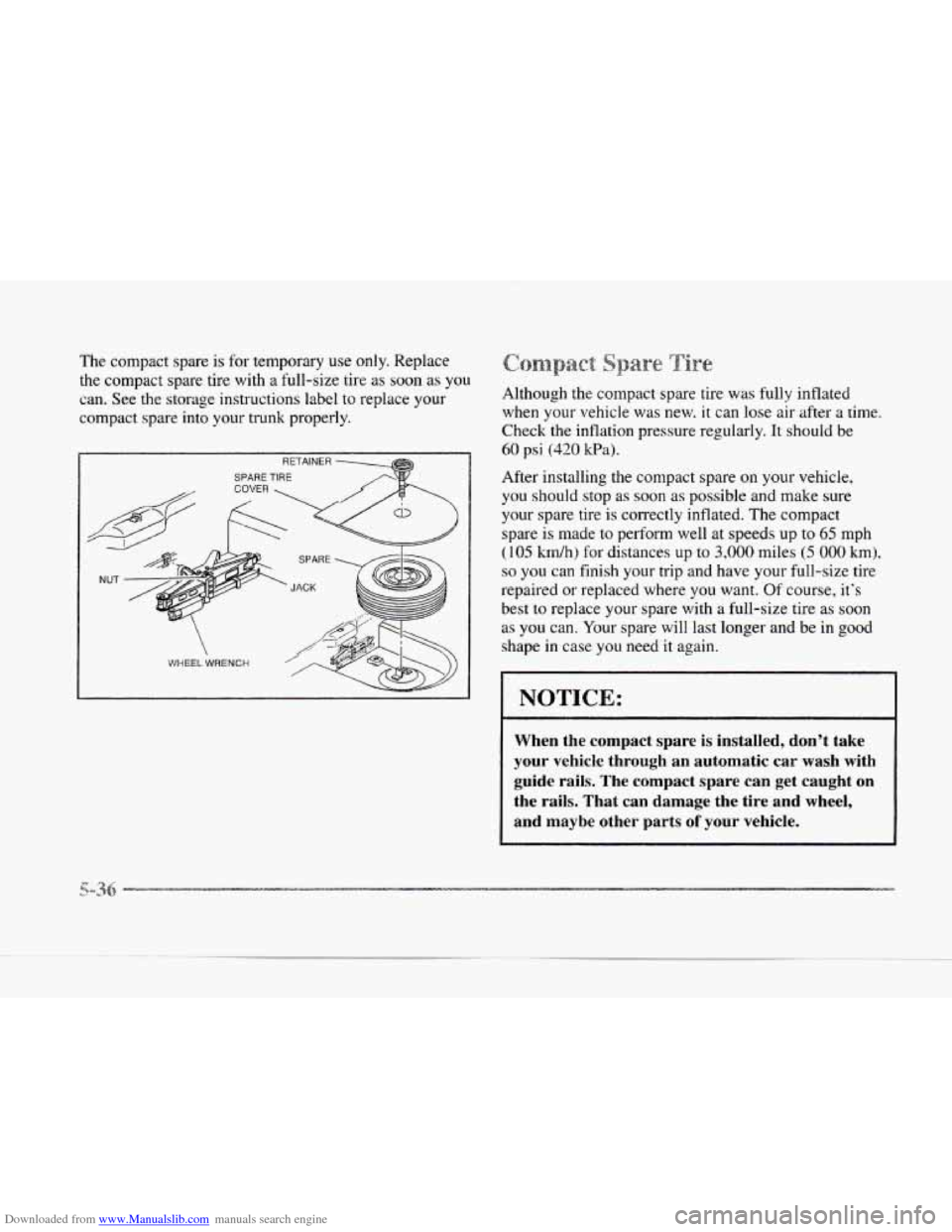1997 CADILLAC SEVILLE wheel size
[x] Cancel search: wheel sizePage 10 of 370

Downloaded from www.Manualslib.com manuals search engine c
c
c
advances such as air suspension, memory seat,
automatic electric door locks. transistor radio,
a brushecl
stainless
steel roof and low profile tires.
For the 1948 model, Cadillac introduced the legendary
tail fin which once more set the trend in automotive
styling for nearly two decades. This
was closely
followed with the two door hardtop Coupe DeVille and
the industry's first modern overhead valve, high
compression
V8 engine on the 1949 model.
Engineering innovations, conveniences
and styling
dominated the
'50s and '60s. Cruise control, automatic
climate control, tilt
and telescoping steering wheels,
twilight sentinel and
four door hard tops all debuted in
these years.
Ir, 1557 the Eldorado Brougham featured
1957 Eldorado Brougham
:.x
The Eldorado, introduced in 1953, was redesigned for
1967
as the first front wheel drive personal luxury car.
The
472 cu. in. V8 engine used in all Cadillacs in I568
and 1965 was enlarged to SO0 cu. in. for all 1970
through 1976 Eldorados. The Track Master
conlputerized skid control braking system option
debuted
on 1970 Eldorados.
A driver and passenger Air Cushion Restraint
system (air bag) was available on
all 1974. I975 and
1976 Cadillacs.
Analog Electronic
Fuel Injection was available, on
1975 Cadillacs and standard 011 the new international
size
1976 Seville. In 1978, the Trip Computer option
incorporated the first on-board microprocessor.
ix
Page 265 of 370

Downloaded from www.Manualslib.com manuals search engine NOTICE:
Improperly tightened wheel nuts can lead to
brake pulsation and rotor damage.
To avoid
expensive brake repairs, evenly tighten the wheel
nuts in the proper sequence and to the proper
torque specification.
Don’t try to put a wheel cover on your compact spare
tire.
It won’t fit. Store the wheel cover in the trunk
until you have the flat tire repaired or replaced.
I NOTICE:
Wheel covers won’t fit on your compact spare. If
you try to put a wheel cover on your compact
spare, you could damage the cover or the spare. Storing
a jack, a tire or other
equipment in the
passenger compartment
of the vehicle could
cause injury. In
a sudden stop or collision, loose
equipment could strike someone. Store all these
in the proper place.
After you’ve put the compact spare tire on your vehicle,
you’ll need to store the flat tire in your trunk. Use the
following procedure
to secure the flat tire in the trunk.
Put the flat tire in the trunk so the side that faces out
when it is on the vehicle is facing down. The full-size
tire will
not fit down into the well. Place it so the front is
in the well and the rear is out of the well.
Y
Page 267 of 370

Downloaded from www.Manualslib.com manuals search engine The compact spare is for temporary use only. Replace
the compact spare tire with
a full-size tire as soon as you
can. See the storage instructions label to replace your
compact spars into your trunk properly.
RETAINER
SPARE TIRE
WHEEL WRENCH
Although the compact spare tire was fully inflated
when your vehicle was new.
it can lose air after a time.
Check the inflation pressure regularly.
It should be
60 psi (420 kPa).
After installing the compact spare on your vehicle,
you should stop as soon as possible and make sure
your spare tire
is correctly inflated. The compact
spare is made
to perform well at speeds up to 65 mph
(1 05 km/h) for distances up to 3,000 miles (5 000 km),
so you can finish your trip and have your full-size tire
repaired or replaced where
you want. Of course, it’s
best
to replace your spare with a full-size tire as soon
as you can. Your spar!: will last longer and be in good
shape in case you need it again.
NOTICE:
When the compact spare is installed, don’t take
your vehicle through an automatic car wash with guide rails.
The compact spare can get caught on
the rails. That can damage the tire and wheel,
and maybe other parts
of your vehicle.
I
L.
Page 311 of 370

Downloaded from www.Manualslib.com manuals search engine A CAUTION:
I
Rust or dirt on a wheel, or on the parts to which
it
is fastened, can make wheel nuts become loose
after a time. The wheel could come off and cause
an accident. When you change a wheel, remove
any rust or dirt from places where the wheel
attaches to the vehicle.
In an emergency, you can
use a cloth
or a paper towel to do this; but be
sure to use a scraper
or wire brush later, if you
need to, to get all the
rust or dirt off. (See
“Changing a Flat Tire” in the Index.)
One way to tell when it’s
time for new tires
is to
check the treadwear
indicators, which will
appear when
your tires have
only
1/16 inch (1.6 mm) or
less
of tread remaining.
.-
You need a new tire ifzany of the following statements
are true:
You can see the indicators at three or more places
a You can see cord or fabric showing through the
0 The tread or sidewall is cracked, cut or snagged deep
enough
to show cord or fabric.
The tire has a bump, bulge or split.
The tire has a puncture, cut or other damage that
around the tire.
tire’s rubber.
can’t
be repaired well because of the size or location
of the damage.
Page 312 of 370

Downloaded from www.Manualslib.com manuals search engine LI
c
Y
To find out what kind and size of tires you need, look at
the Tire-Loading Information label.
The tires installed on your vehicle when
it was new had
a Tire Performance Criteria Specification (TPC Spec)
number
on each tire's sidewall. When you get new tires,
your vehicle will continue to have tires that are designed
to give proper endurance: handling, speed rating.
traction. ride and other things during normal service
on
your vehicle. If your tires have an all-season tread
design. the
TPC number will be followed by an "MS"
(for mud and snow).
e oet ones with that same TPC Spec number. That way
If you ever replace your tires with those not having a
TBC Spec number, make sure they are the same size,
load range. speed rating and construction type (bias,
bias-belted or radial)
as your original tires.
I A CAUTION:
Mixing tires could cause you to lose control while
driving.
If you mix tires of different sizes or types
(radial and bias-belted tires), the vehicle may not
handle properly, and you could have a crash.
Using tires
of different sizes may also cause
damage to your vehicle. Be sure
to use the same
size and type tires on
all wheels.
It's all right to drive with
your compact spare,
though. It was developed for use
on your vehicle.
Page 316 of 370

Downloaded from www.Manualslib.com manuals search engine c
c 7- -
I NOTICE:
c
L-
Use tire chains only where legal and only when
you must. Use only
SAE Class “S” type chains
that are the proper size for your tires. Install
i them on the front tires and tighten them as
tightly as possible with the ends securely
fastened. Drive slowly and follow the chain
manufacturer’s instructions.
If you can hear the
chains contacting your vehicle, stop and retighten
them.
If the contact continues, siow down until it
stops. Driving too
fast or spinning the wheels
with chains
on will damage your vehicle.
re
Remember, cleaning products can be hazardous. Some
are toxic. Others can burst into flames if
you strike a
match or get them
on a hot part of the vehicle. Some are
dangerous if
you breathe their fumes in a closed space.
When you use anything
from a container to clean your
Cadillac,
be sure to follow the manufacturer’s warnings and
instructions. And always
open your doors or
windows when you’re cleaning the inside.
Na?cnl’ use these to clean your vehicle:
0 Gasoline
e Benzene
0 Naphtha
Carbon Tetrachloride
0 Acetone
Paint Thinner
0 Turpentine
Lacquer Thinner
Nail Polish Remover
They can all be hazardous
-- some more than
others
-- and they can all damage your vehicle. too.
Don’t use any
of these unless this manual says you can.
In many uses, these will damage your vehicle:
Alcohol
0 Laundry Soap
Bleach
0 Reducing Agents